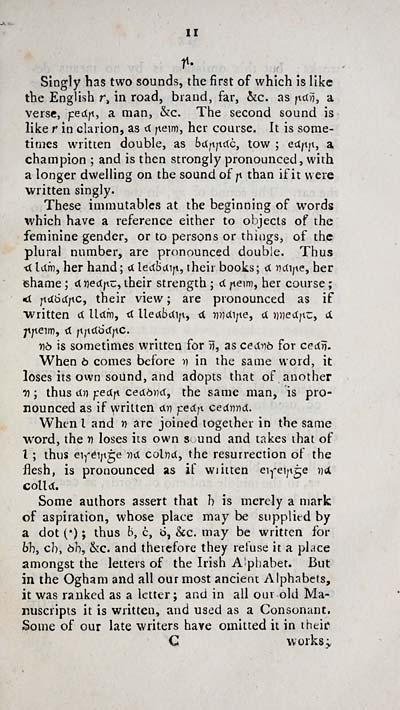Download files
Complete book:
Individual page:
Thumbnail gallery: Grid view | List view

ft
Singly has two sounds, the first of which is like
the English r, in road, brand, far, he. as pidfl, a
verse, ped/i, a man, &c. The second sound is
like r in clarion, as d jteim, her course. It is some-
times written double, as bdftjtdc, tow ; edpm, a
champion ; and is then strongly pronounced, with
a longer dwelling on the sound of j\ than if it were
written singly.
These immutables at the beginning of words
which have a reference either to objects of the
feminine gender, or to persons or things, of the
plural number, are pronounced double. Thus
•d Iccfn, her hand ; d ledbdip, their books ; d ndijte, her
shame ; d nedpz, their strength ; d jteim, her course ;
«x jtdbcCjic, their view ; are pronounced as if
"written d Udm, d tleaBcd^i, d w)di/te, d wjedjti:, d
■jxjxeMro, d f\)\ú'ótiij\c.
nb is sometimes written for «, as ced-ob for cedri.
When 6 comes before d in the same word, it
loses its own soUnd, and adopts that of another
7) ; thus coi pedft cedbvd, the same man, is pro-
nounced as if written <xn pedp. cedmd.
When I and i) arc joined together in the same
word, the r) loses its own s und and takes that of
I ; thus eiféi/tje nd colnd, the resurrection of the
flesh, is pronounced as if wiitten ei^eijige ))d
colld.
Some authors assert that f> is merely a mark
of aspiration, whose place may be supplied by
a dot (*) ; thus b, c, b, &c. may be written for
bh, cb, bh, &c. and therefore they refuse it a place
amongst the letters of the Irish Alphabet. But
in the Ogham and all our most ancient Alphabets,
it was ranked as a letter; and in all our old Ma-
nuscripts it is written, and used as a Consonant.
Some of our late writers have omitted it in their
C works;
Singly has two sounds, the first of which is like
the English r, in road, brand, far, he. as pidfl, a
verse, ped/i, a man, &c. The second sound is
like r in clarion, as d jteim, her course. It is some-
times written double, as bdftjtdc, tow ; edpm, a
champion ; and is then strongly pronounced, with
a longer dwelling on the sound of j\ than if it were
written singly.
These immutables at the beginning of words
which have a reference either to objects of the
feminine gender, or to persons or things, of the
plural number, are pronounced double. Thus
•d Iccfn, her hand ; d ledbdip, their books ; d ndijte, her
shame ; d nedpz, their strength ; d jteim, her course ;
«x jtdbcCjic, their view ; are pronounced as if
"written d Udm, d tleaBcd^i, d w)di/te, d wjedjti:, d
■jxjxeMro, d f\)\ú'ótiij\c.
nb is sometimes written for «, as ced-ob for cedri.
When 6 comes before d in the same word, it
loses its own soUnd, and adopts that of another
7) ; thus coi pedft cedbvd, the same man, is pro-
nounced as if written <xn pedp. cedmd.
When I and i) arc joined together in the same
word, the r) loses its own s und and takes that of
I ; thus eiféi/tje nd colnd, the resurrection of the
flesh, is pronounced as if wiitten ei^eijige ))d
colld.
Some authors assert that f> is merely a mark
of aspiration, whose place may be supplied by
a dot (*) ; thus b, c, b, &c. may be written for
bh, cb, bh, &c. and therefore they refuse it a place
amongst the letters of the Irish Alphabet. But
in the Ogham and all our most ancient Alphabets,
it was ranked as a letter; and in all our old Ma-
nuscripts it is written, and used as a Consonant.
Some of our late writers have omitted it in their
C works;
Set display mode to: Large image | Transcription
Images and transcriptions on this page, including medium image downloads, may be used under the Creative Commons Attribution 4.0 International Licence unless otherwise stated. ![]()
| Early Gaelic Book Collections > Hew Morrison Collection > Practical grammar of the Irish language > (25) |
|---|
| Permanent URL | https://digital.nls.uk/76734453 |
|---|
| Description | A selection of items from a collection of 320 volumes and 30 pamphlets of literary and religious works in Scottish Gaelic. From the personal library of Hew Morrison, the first City Librarian of Edinburgh. |
|---|
| Description | Selected items from five 'Special and Named Printed Collections'. Includes books in Gaelic and other Celtic languages, works about the Gaels, their languages, literature, culture and history. |
|---|

